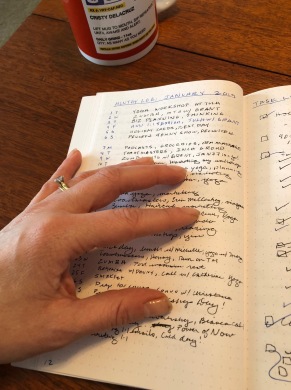People have often recommended to me that I must try a bullet journal, if I truly want to keep myself organized. When I watched Ryder Carroll’s You Tube video on why and how he created the bullet journal for himself, I definitely felt that “click” in my brain that tells me someone is speaking my language. (Sometimes it’s more of a tingle in my spine rather than an actual click, but you get my point.)

Carroll titles his Ted Talk “How to Declutter Your Mind” and he talks about his experience with a.d.d., which he eventually outgrew. In the process, he designed a system to help him keep track of things, while also being mindful about not wanting to focus on too many different things at once.
We live in a world with so many choices, and for many of us, more freedom than ever. This is why minimalist living has become increasingly appealing to me. Decision fatigue is a real thing. And for those of us who struggle with some attention issues, de-cluttering our minds by creating a mental inventory and writing things down is important.
Once it is written down, we can ask ourselves: do these things matter? Or are they just fleeting notions that take up mental space? Once we cross off those items that do not matter, or that we truly do not need to do, the list gets smaller.
Paying attention to “small projects” that hold our curiosity and recording these, we intentionally make space in our lives to do them. Carroll breaks these into month-long chunks, because it makes them more manageable.
Over time, we make adjustments, through a periodic process of reflection. We keep the mental inventory updated each day (more videos here if you want to explore). On a monthly basis, we take a more top-oriented view, setting intentions that are longer-term in nature.
I tried the practice in January to see if it works for me, and I discovered a few things:

- I love the idea of looking 3-6 months and putting a “future log” on paper to approximate when I want to complete certain things. Even if you don’t anticipate everything, it helps set direction.
- The monthly log rocks. One line per day, really got me to reflect on only 2-3 high level things I accomplished in that day. It was a nice way to look back and see what I did that month in a 1-page summary.
- The daily logs are a struggle for me. I am customizing the bullet process, and the migration process to my own brand of check boxes and “swivels” to bring forward the tasks I want to keep. But that is what Ryder recommended anyway. It is why bullet journals are mostly blank – YOU fill in the system that works.
- You must exercise compassion. I did not sit down and do my February plan until the 7th of the month!! I think I was reluctant to admit that I didn’t follow the exact program in January (and I didn’t want to beat myself up over the things I did not finish). But I am using compassion with myself to migrate the tasks that are still relevant, and cross out the ones that obviously were not.
I may write about this experiment again in a month, because I am curious about whether February’s efforts will be refined. I want to improve and customize. I should mention that I still do a “shape of the week” in parallel in which I graph out one full week and fill in the sections with my overall time chunks, and then track actual time.
For those of you who have taken the “bullet journal” path – does it work for you? What clever modifications have you added to make it even more functional?
cristy@meximinnesotana.com

Excellent advices, love it. Thank you so much!
LikeLiked by 1 person
Love TED talks, will follow up the recommendation.
LikeLiked by 1 person